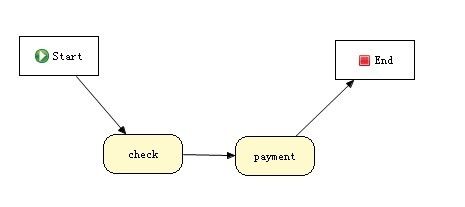基于Drools 规则引擎的信用卡申请系统<4> 之 Drools 实现业务规则
设计规则流如下:
先执行:check,然后执行payment
对应的规则流rmf文件如下: 【使用IDE生成,Drools4.0.7 的可读性,不如Drools 5】
<org.drools.ruleflow.core.impl.RuleFlowProcessImpl id="1">
<nodes id="2">
<entry>
<long>1</long>
<org.drools.ruleflow.core.impl.StartNodeImpl id="3">
<id>1</id>
<name>Start</name>
<incomingConnections id="4"/>
<outgoingConnections id="5">
<org.drools.ruleflow.core.impl.ConnectionImpl id="6">
<type>1</type>
<from class="org.drools.ruleflow.core.impl.StartNodeImpl" reference="3"/>
<to class="org.drools.ruleflow.core.impl.RuleSetNodeImpl" id="7">
<ruleFlowGroup>check</ruleFlowGroup>
<id>3</id>
<name>check</name>
<incomingConnections id="8">
<org.drools.ruleflow.core.impl.ConnectionImpl reference="6"/>
</incomingConnections>
<outgoingConnections id="9">
<org.drools.ruleflow.core.impl.ConnectionImpl id="10">
<type>1</type>
<from class="org.drools.ruleflow.core.impl.RuleSetNodeImpl" reference="7"/>
<to class="org.drools.ruleflow.core.impl.RuleSetNodeImpl" id="11">
<ruleFlowGroup>payment</ruleFlowGroup>
<id>4</id>
<name>payment</name>
<incomingConnections id="12">
<org.drools.ruleflow.core.impl.ConnectionImpl reference="10"/>
</incomingConnections>
<outgoingConnections id="13">
<org.drools.ruleflow.core.impl.ConnectionImpl id="14">
<type>1</type>
<from class="org.drools.ruleflow.core.impl.RuleSetNodeImpl" reference="11"/>
<to class="org.drools.ruleflow.core.impl.EndNodeImpl" id="15">
<id>2</id>
<name>End</name>
<incomingConnections id="16">
<org.drools.ruleflow.core.impl.ConnectionImpl reference="14"/>
</incomingConnections>
<outgoingConnections id="17"/>
</to>
</org.drools.ruleflow.core.impl.ConnectionImpl>
</outgoingConnections>
</to>
</org.drools.ruleflow.core.impl.ConnectionImpl>
</outgoingConnections>
</to>
</org.drools.ruleflow.core.impl.ConnectionImpl>
</outgoingConnections>
</org.drools.ruleflow.core.impl.StartNodeImpl>
</entry>
<entry>
<long>2</long>
<org.drools.ruleflow.core.impl.EndNodeImpl reference="15"/>
</entry>
<entry>
<long>3</long>
<org.drools.ruleflow.core.impl.RuleSetNodeImpl reference="7"/>
</entry>
<entry>
<long>4</long>
<org.drools.ruleflow.core.impl.RuleSetNodeImpl reference="11"/>
</entry>
</nodes>
<variables id="18"/>
<lastNodeId>4</lastNodeId>
<id>myflow</id>
<name>MyFlow</name>
<version>1.0</version>
<type>RuleFlow</type>
<packageName>com.chen.drools</packageName>
</org.drools.ruleflow.core.impl.RuleFlowProcessImpl>
规则文件如下:
清单一:rules.drl
package com.chen.drools
#list any import classes here.
import com.chen.beans.User;
#declare any global variables here
#如果申请人既没房也没车,同时学历为大专及以下,并且月薪少于5000,那么不通过。
rule "No1"
ruleflow-group "check"
when
#conditions
$user: User(hasHouse =="无", hasCar =="无", degree =="大专以下", salary <5000)
then
#actions
$user.setApprove(false);
end
#如果申请人既没房也没车,同时学历为大专或本科,并且月薪少于3000,那么不通过。
rule "No2"
#include attributes such as "salience" here...
ruleflow-group "check"
when
#conditions
$user: User( hasHouse =="无", hasCar =="无", salary <3000,( degree =="大专" || degree =="本科"))
then
#actions
$user.setApprove(false);
end
#如果申请人既没房也没车,同时学历为本科以上,并且月薪少于2000,同时之前没有信用卡的,那么不通过。
rule "No3"
ruleflow-group "check"
when
$user:User( hasHouse =="无", hasCar =="无", degree =="本科以上", salary <2000)
then
$user.setApprove(false);
end
清单二: payment.drl
package com.chen.drools
#list any import classes here.
import com.chen.beans.CardInfo;
import com.chen.beans.User;
//如果申请人有房有车,或者月收入在20000以上,那么发放的信用卡信用额度为15000
rule "R1"
ruleflow-group "payment"
when
$user: User( salary >20000 || (hasCar =="有" && hasHouse =="有") )
$card: CardInfo( )
then
$user.setCardInfo($card);
$card.setValue(15000);
$card.setBankName("中银广州");
$card.setUser($user);
#creatPayment(15000,$user);
#输出测试
end
//如果申请人没房没车,但月收入在10000~20000之间,那么发放的信用卡信用额度为6000
rule "R2"
#include attributes such as "salience" here...
ruleflow-group"payment"
when
#conditions
$user: User( hasHouse =="无" , hasCar =="无" , salary >10000 , salary <20000 )
$card: CardInfo( )
then
#actions
$user.setCardInfo($card);
$card.setValue(6000);
$card.setBankName("中银广州2");
$card.setUser($user);
#creatPayment(6000,$user);
end
//如果申请人没房没车,月收入在10000以下,那么发放的信用额度为3000。
rule "R3"
ruleflow-group"payment"
when
$user : User( hasHouse =="无", hasCar =="无" , salary <10000 )
$card: CardInfo( )
then
$user.setCardInfo($card);
$card.setValue(3000);
$card.setBankName("中银广州3");
$card.setUser($user);
end
//如果申请人有房没车或者是没房但有车,月收入在10000以下,那么发放的信用额度为5000。
rule "R4"
ruleflow-group"payment"
when
$user : User( ( hasHouse =="有" && hasCar =="无") || (hasHouse =="无" && hasCar =="有") && salary <10000 )
$card: CardInfo( )
then
$user.setCardInfo($card);
$card.setValue(5000);
$card.setBankName("中银广州4");
$card.setUser($user);
end
// 如果申请人有房没车或者是没房但有车,月收入在10000~2000之间,那么发放的信用额度为8000。
rule "R5"
ruleflow-group"payment"
when
$user: User( (hasHouse =="有" && hasCar =="无") || (hasHouse =="无" && hasCar =="有") && salary <= 20000 , salary >=10000 )
$card: CardInfo( )
then
$user.setCardInfo($card);
$card.setValue(8000);
$card.setBankName("中银广州5");
$card.setUser($user);
end
